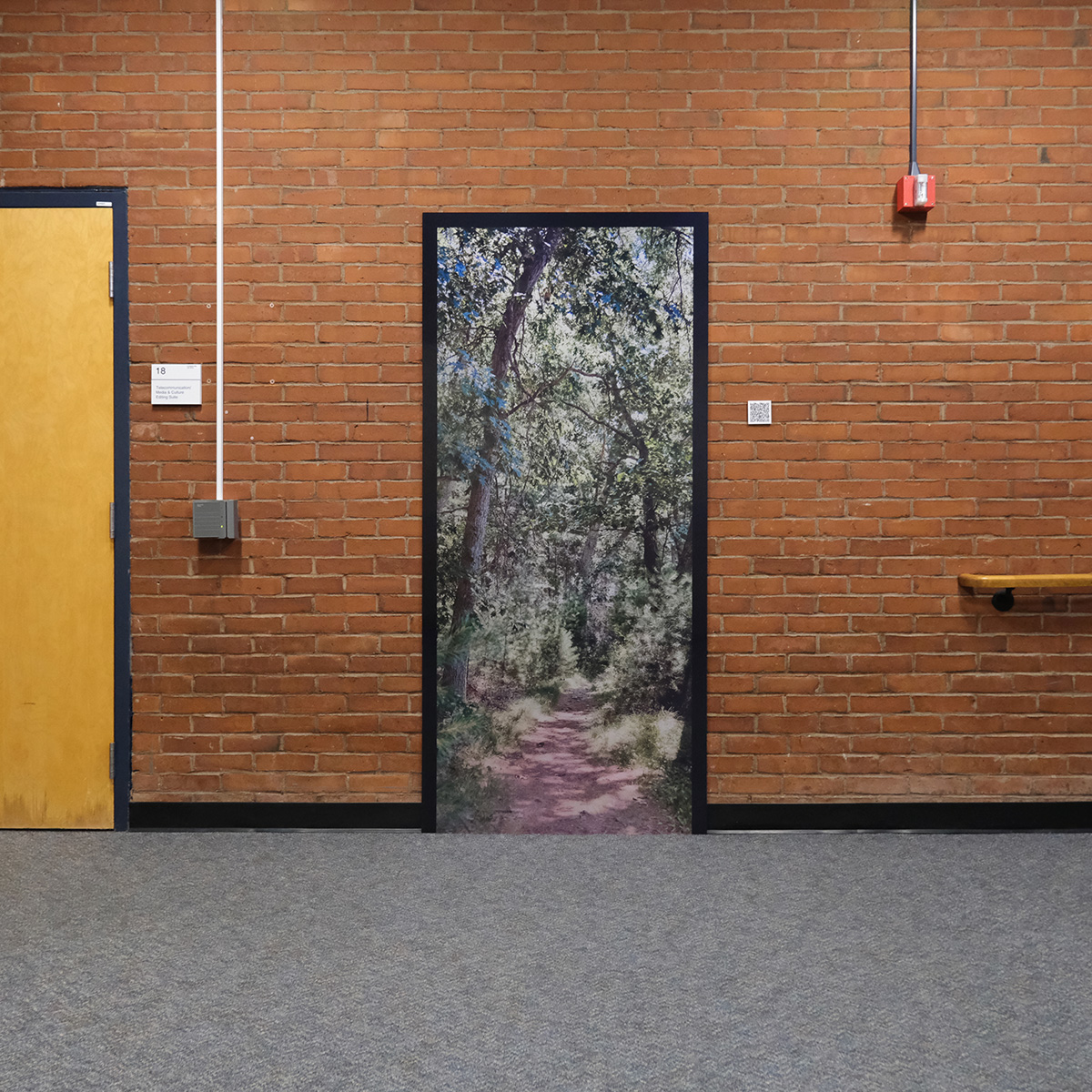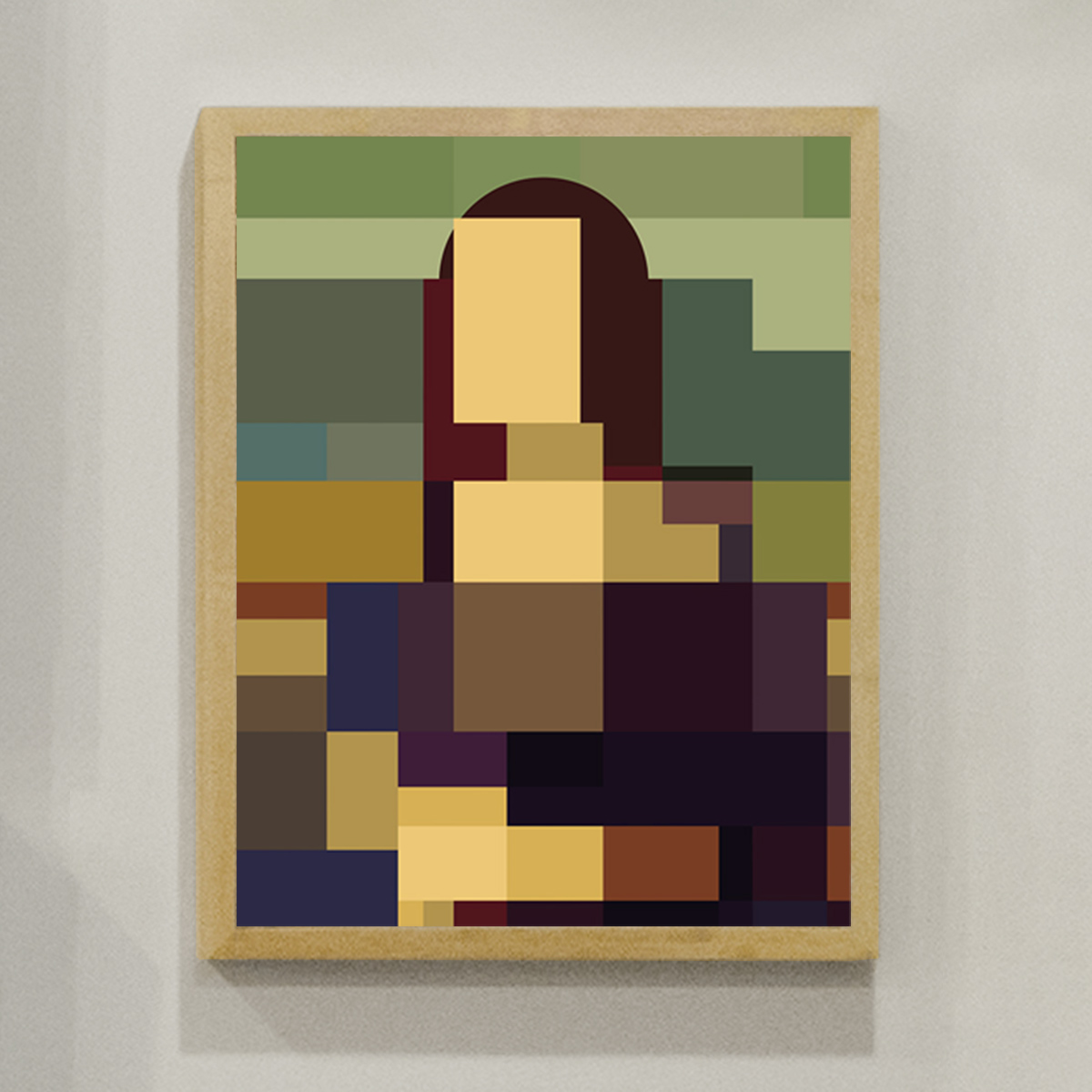Posted on March 10, 2025 by admin_facta -

Portal to Elliot Concord River Preserve is a trompe-l’œil three-stage lenticular public art intervention by Dan Vlahos, Senior Lecturer of English and Media Studies at Bentley University. This work is currently installed in the lower level of Bentley’s Lindsay Hall—just footsteps from the University’s Film and Media Studies Lab. This work was funded through a private research grant from the Academic Advisory Council for Signage Research and Education (AACSRE)—a 501(3)c not-for-profit organization founded in 2015. The three images used to generate this portal were captured on a nature trail within the Elliott Concord River Preserve in Carlisle, MA.
To attain the rough proportions of a “door” a 1.33X anamorphic photo lens was used to capture the high-resolution imagery. When “desqueezed” the imagery has a 2.4:1 ratio. While anamorphic lenses are primarily known for their cinematic landscape proportions and unique bokeh effects, using the lens to capture portrait images for the portal project was found to be ideal. Conceptually, the work strives to be illogically logical and dynamic without power. It also suggests that the whimsical, discursive, and subversive can live alongside evidence-based design.
A QR code that links to a short survey sits beside the work. Responses and reactions are being collected via this 3-5 minute anonymous survey. In the fall of 2025, these responses will be evaluated and disseminated in a contextual case study about this project. The final case study will be published in the Interdisciplinary Journal of Signage and Wayfinding.
Media—
Specifications and Credits—
- Lenticular printing: Visual Creative Graphics Innovations, San Jose, CA
- Research Advisor: Ellen Babcock, Associate Professor: Art Practices, Department of Art, College of Fine Arts, The University of New Mexico
- Camera: Fujifilm X-S10
- Lens: SIRUI 24mm F2.8 Anamorphic (X-Mount)
Related talks—
- “Hallway Talk,” Bentley University, Lindsay Hall. March 25, 2025.
- “Portal to Elliot Concord River Preserve,” English and Media Studies Research Forum, LaCava Center, Bentley University, March 26, 2025.
Posted on September 22, 2022 by admin_facta -

How do we ponder and define community and place? These five photographs were produced for and exhibited in the 2019 exhibition Mission Hill: Presence, Absence and Transformation. The images were also included in the limited-edition exhibition catalog accompanying the show. The project was led by Dragan Grujic, founder of the Boston-based INFocus Camera Club. The exhibition opened in June 2019 and was presented in two galleries in Boston’s Brigham Circle district.
For over twenty years, I resided and maintained my design studio in Boston’s urban neighborhood of Mission Hill. Often, as I walked my street, I reflected upon my time as a child and the connections I developed in my hometown, most notably on the street where I grew up. While I secured many meaningful friendships and connections on Mission Hill, most of the residents remained largely anonymous and transient.
From 2018–2019 I committed to exploring my street through photography—seeking the connections between and reflecting upon notions of neighborhoods and communities. Over time my photographic focus became the dehumanized yet richly textured numbers and ephemera on the front of each house.
Shortly after the exhibition opened, I received two emails from two separate people who were each seeking to purchase the same print of a front door on Mission Hill. Each email separately shared that both said the reason for wanting the print was because it was the house where they had each met their spouse. Lo and behold, the couple had reached out simultaneously without even knowing it.
Credits—
Camera: Nikon D5300
Curator: Dragan Grujic
Sponsor: INFocus Camera Club, Boston
Posted on March 15, 2021 by admin_facta -

This abstract series of digital drawings explored the hidden structure and geometry in art, architecture and design. The series began after reading Geometry of Design: Studies in Proportion and Composition by Kimberly Elam. The book focuses not only on the classic systems of proportioning, such as the golden section and root rectangles, but also on less well known proportioning systems such as the Fibonacci Series.
Starting in the early 2000s, while I was mostly creating design work for Volkswagen I began “tracing” the vehicles in my layout software (then QuarkXPress). For a period of time this became a bit of a hobby (tracing various objects and then creating graphic/colorized/linework versions of them). I would then output the tracings in inkjet—onto canvas and then occasionally frame them. I traced chairs, turntables, cars, appliances, buses and famous western paintings. And in a weird way, at the time these were all attempts for me to understand and “decode” design. These framed prints were sold at local air fairs and given to friends and family.
To my surprise one of these compositions, of a Volkswagen New Beetle, took third place in Strathmore’s 2004 Digital Media Art Contest. Then, one of my abstract renderings of the Mona Lisa, which I created almost exclusively out of golden section rectangles and squares directly informed my dynamic media project MetaPieces in 2015.
Posted on March 15, 2021 by admin_facta -

CMYKW, the four colors traditionally used in offset lithography (cyan, magenta, yellow and black) plus white represent the highly limited color palette used in this long standing series of acrylic paintings. Using monoprinting techniques and then over time painting with brayers and palette knives the paintings were oftentimes partially or fully sanded and then repainted over after the painting was dry. This process was often repeated many times sometimes over long periods of time.
The paintings are partially inspired by the photography work of Jurek Wajdowicz and the 2005 exhibition The Shape of Colour: Excursions in Color Field Art held at the Art Gallery of Ontario. I became interested in Color Field paintings in my art history and studio art courses at MassArt in the late 1990s. Color Field paintings are generally characterized by large fields of flat or solid color spread across the surface creating an unbroken and flat picture plane.
Most of these works were created while listening to jazz music—especially live improvisational works by the American pianist Keith Jarrett. Several of the paintings pay direct homage to Jarrett and his work. Whenever possible the paintings were made outdoors or in nature—usually with the canvas or surface placed parallel to the surface/ground rather than on an easel or stand.
Collections—
Sold at auction and private sale.




Recent Comments